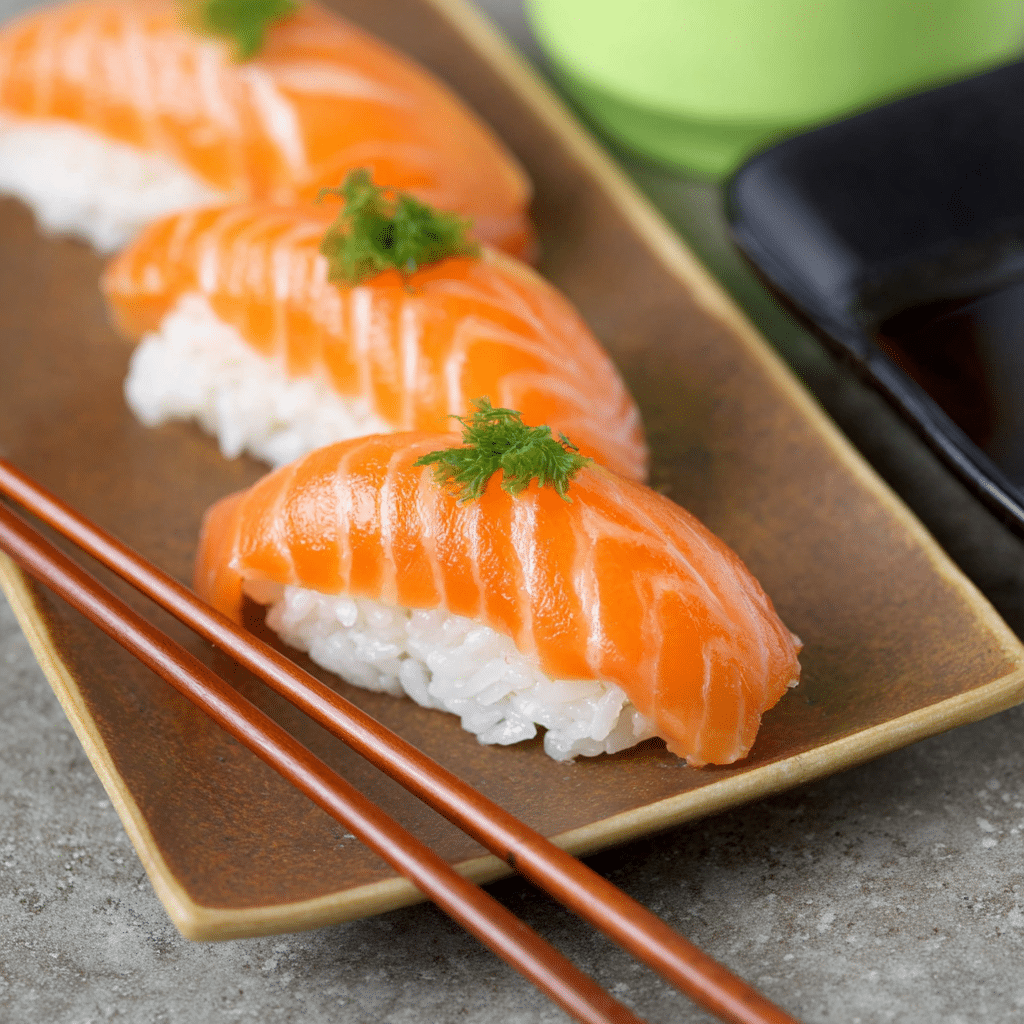The art of sushi doesn’t have to stay behind a restaurant counter. With a few simple ingredients and a bit of technique, you can create stunningly fresh salmon nigiri at home that rivals your favorite sushi spot.
This hand-pressed sushi combines slightly vinegared rice with buttery, sushi-grade salmon slices for a dish that is both elegant and effortless. Whether you’re entertaining or just treating yourself to something refined, this recipe captures the soul of traditional Japanese simplicity in every bite.
Full Recipe
Ingredients:
-
1/2 lb sushi-grade salmon, thinly sliced
-
2 cups sushi rice
-
2 1/2 cups water
-
1/3 cup rice vinegar
-
3 tablespoons sugar
-
1 teaspoon salt
-
Wasabi paste (optional)
-
Soy sauce, for serving
-
Pickled ginger, for serving
Directions:
-
Rinse the sushi rice under cold water until the water runs clear. Drain well.
-
In a rice cooker or saucepan, combine the rice with 2 1/2 cups water. Cook according to rice cooker instructions or bring to a boil, reduce to low, cover, and simmer for 18 minutes. Let it sit covered for 10 more minutes.
-
While the rice is still warm, transfer it to a large bowl. In a small saucepan, combine rice vinegar, sugar, and salt. Heat over low until sugar and salt are dissolved. Pour over the rice and gently fold to incorporate without mashing the grains. Let cool to room temperature.
-
Wet your hands with a mixture of water and a little rice vinegar to prevent sticking. Take a small amount of rice (about 2 tablespoons) and shape it into an oval using light pressure.
-
(Optional) Add a tiny dab of wasabi to one side of the salmon slice.
-
Press the salmon slice over the rice oval, gently pressing to adhere. Repeat with remaining rice and salmon.
-
Serve immediately with soy sauce and pickled ginger on the side.
Prep Time: 20 minutes | Cooking Time: 20 minutes | Total Time: 40 minutes
Kcal: 140 kcal per piece | Servings: 10 pieces
Introduction to Salmon Nigiri
Salmon Nigiri is one of the most iconic and beloved forms of sushi. At its core, it consists of two main components: a carefully molded oblong of vinegared sushi rice and a thin slice of raw salmon laid over the top. But don’t be fooled by its simplicity. This bite-sized piece of Japanese culinary art captures a complex harmony of texture, temperature, flavor, and technique. Popular not only in Japan but around the world, Salmon Nigiri is often a beginner’s entry into the world of raw fish dishes due to its mild, buttery flavor and approachable presentation.
What sets Salmon Nigiri apart is its ability to showcase the quality of its ingredients. When done right, the rice is tender yet firm, slightly sweet, and tangy with rice vinegar, while the salmon is silky, rich, and melts in your mouth. Sushi chefs train for years to master the shaping and balance of nigiri. Thankfully, with the right knowledge, home cooks can achieve impressive results as well.
Cultural Significance of Nigiri Sushi
Nigiri is part of a broader family of sushi, which includes maki (rolled sushi), temaki (hand rolls), and sashimi (sliced raw fish without rice). The term “nigiri” comes from the Japanese verb nigiru, meaning “to grasp” or “to hold,” referring to the way the sushi rice is formed by hand. Nigiri-style sushi originated during the Edo period in Japan (1603–1868) as a fast food in bustling Tokyo (then known as Edo). It was meant to be eaten with the fingers and served in moments — essentially the sushi version of street food.
Salmon, on the other hand, is a relatively new addition to the world of traditional Japanese sushi. For many years, raw salmon was avoided in Japan due to concerns about parasites. It wasn’t until the 1980s when Norway began exporting parasite-free salmon to Japan that it gained widespread popularity. Now, it’s nearly impossible to find a sushi restaurant menu without salmon nigiri, and it’s often a favorite among sushi newcomers and connoisseurs alike.
Choosing the Right Salmon for Nigiri
The success of Salmon Nigiri depends largely on ingredient quality, especially the salmon itself. Not just any salmon will do. To safely consume it raw, you need sushi-grade or sashimi-grade salmon — terms that generally indicate the fish has been frozen at specific temperatures to kill any parasites. Always purchase your fish from a reputable source and let your fishmonger know that you plan to eat it raw.
Atlantic salmon is most commonly used due to its fatty, rich texture, but wild-caught Pacific salmon can also be used if it’s properly handled. The flesh should be vibrant, with a clean smell, and firm to the touch. Avoid fish that has a dull color or strong odor.
Mastering the Art of Sushi Rice
While the salmon is the star, the rice is the backbone of any nigiri. Sushi rice (shari) must be short-grain or medium-grain and properly seasoned with a mixture of rice vinegar, sugar, and salt. The process of cooling and seasoning the rice while gently folding (not mashing) is essential to achieving the ideal texture and flavor balance.
Shaping the rice for nigiri requires clean, moist hands and a delicate touch. Each piece should be uniform in size — traditionally about two fingers wide — and firm enough to hold its shape while still being tender when bitten. This takes practice, but it’s a fun and rewarding skill to learn.
Wasabi, Soy Sauce, and Traditional Toppings
In traditional Japanese sushi, a small dab of wasabi is often placed between the rice and the fish. This isn’t just for flavor; wasabi has antibacterial properties and enhances the freshness of the fish. That said, many western adaptations serve wasabi on the side to allow diners to control the spice level themselves.
Soy sauce is typically served on the side for dipping. However, it’s important to dip only the fish side — not the rice — to avoid overpowering the delicate balance of flavors or causing the rice to fall apart. In high-end sushi dining, sushi is often already brushed lightly with a specially prepared soy-based sauce (nikiri), and additional dipping is discouraged.
Pickled ginger (gari) is served as a palate cleanser between different types of sushi. Its slightly sweet and acidic flavor refreshes the taste buds and prepares the mouth for the next bite.
Pairing Salmon Nigiri with Beverages
Salmon Nigiri pairs beautifully with a range of beverages. A classic match is sake, especially one with a clean and slightly dry profile like Junmai or Ginjo. These highlight the umami and natural sweetness of the fish without overwhelming it.
For wine lovers, opt for a crisp, unoaked white wine such as Sauvignon Blanc or a light Pinot Grigio. The acidity and citrus notes work well with the richness of the salmon. Even sparkling wines and Champagne can make for a delightful pairing, adding a festive fizz to the delicate experience.
If you’re avoiding alcohol, a chilled Japanese green tea like sencha or genmaicha provides an earthy, slightly bitter balance that complements the sweetness of the rice and the rich texture of the fish.
Serving and Presentation Tips
Presentation is a key component of sushi culture. Salmon Nigiri should be served on a clean, minimalist plate or slate board, often with a few garnishes like pickled ginger and wasabi. Simplicity allows the colors and textures of the nigiri to shine.
For a more elevated experience, consider using Japanese-style ceramic or lacquerware. If making a sushi platter, arrange nigiri pieces in neat rows and balance the plate with color contrast — perhaps with some cucumber maki or tamago (Japanese omelet sushi) for visual diversity.
Serving the nigiri fresh is vital — ideally within 30 minutes of preparing — to preserve the texture and temperature balance between the slightly cool salmon and room-temperature rice.
Why You Should Try Making Salmon Nigiri at Home
One of the joys of making Salmon Nigiri at home is the connection it brings to Japanese culinary tradition. It encourages mindfulness, attention to detail, and appreciation for simple, high-quality ingredients. While it may seem intimidating at first, home sushi-making is surprisingly achievable once you understand the basics.
It’s also a great activity to share with friends or family. Hosting a sushi night can turn into an interactive dinner party, where guests try their hand at shaping nigiri or customizing their toppings. Plus, making it yourself often means fresher, cleaner, and more affordable sushi compared to restaurant dining.
Nutritional Benefits of Salmon Nigiri
Salmon Nigiri is more than just tasty — it’s also quite nutritious. Salmon is a fantastic source of omega-3 fatty acids, vitamin D, B12, and protein, all of which support heart health, brain function, and energy levels. When paired with sushi rice — which offers carbohydrates and trace minerals — it makes for a well-rounded bite.
Compared to fried or heavily sauced dishes, nigiri is relatively low in calories and free from additives. It’s also naturally gluten-free if you use gluten-free soy sauce, making it suitable for many dietary needs.
Common Mistakes to Avoid
While Salmon Nigiri is simple in concept, there are a few common pitfalls. Using non-sushi-grade fish is the biggest risk — never compromise on quality when eating raw seafood. Over-handling the rice can result in a mushy or overly compact texture, while under-seasoning it will lead to a bland bite.
Another mistake is using too much wasabi or soy sauce, which can overpower the delicate flavor of the salmon. Balance is everything in sushi — each element should enhance the other, not compete with it.
Lastly, make sure to keep your preparation area clean and cold. Sushi safety and hygiene are crucial when working with raw fish.
Conclusion
Salmon Nigiri is more than just a trendy sushi item — it’s a time-honored dish that captures the essence of Japanese cuisine: precision, harmony, and respect for ingredients. Whether you’re a seasoned sushi lover or new to making raw fish at home, learning to craft Salmon Nigiri offers both a delicious reward and a deep appreciation for culinary craftsmanship.
With a little practice and attention to detail, you can create beautiful, restaurant-quality nigiri that’s perfect for intimate dinners, celebrations, or simply satisfying your sushi cravings. The next time you reach for a sushi menu, consider taking the leap and making it yourself — your taste buds (and your guests) will thank you.






